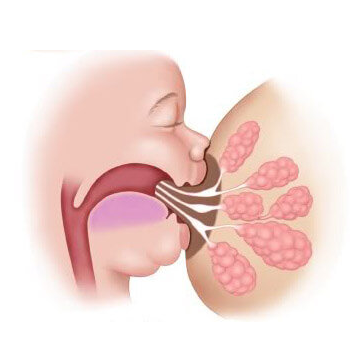Obviously, knowing what I know now, I wish I had taken care of it earlier. And that’s why I am so passionate about educating moms. What I went through is entirely preventable.”
– Dr. Loria Nahatis
“Nursing my son was difficult from the start. It hurt and frustrated me. I was always sore. My son, bless his heart, was constantly “gumming” me when he tried to feed. I felt like I was choking him. After 3 or 4 months, he would not feed off of me at all. I didn’t find out until much later that it was a posterior tongue tie that was causing the problems.”
“She was always ‘refluxy’ and ‘spitty’ and her sleep wasn’t good at all.”
– Dr. Carla Damon
“My daughter was tongue tied at birth. Fortunately, I was familiar with the concept of tethered oral tissue and had her “released”. In retrospect, though, I don’t think the release went far enough. Nursing wasn’t always easy for her. Now, at age 3, she has narrow jaws and crowded teeth. The results from a recent sleep test suggest that her airway is not developing in an ideal way.
I wish I knew as much about tongue ties when she was born as I do now. Like Dr. Loria, I’m passionate about educating moms because my experience is that problems related to tongue and lip ties are preventable and treatable.”
Friday By Appointment
What is a frenectomy?
A frenectomy is a relatively minor surgical procedure performed to release a tongue or lip tie. During a frenectomy, we loosen or remove overly large, tight, or poorly positioned band(s) of tissue that are present inside the mouth, connected to the lip, cheeks or floor of the mouth (frenum).
Why are infant frenectomies different than older child or adult frenectomies?
Infants use breastfeeding or paced bottle feeding as a starting point for the rehabilitation post release whereas an adult or older child uses myofunctional therapy as the therapy to help repattern or retrain the tongue.
Optimal Feeding Versus Restricted Feeding

Optimal
Note the tongue position – the tongue is past the ridge of where the teeth would be. The nipple is deeply inserted and tongue is able to push nipple against the palate.

Restricted
Note the tongue position here – the tongue is not able to go past the ridge of where the teeth would be. The nipple is unable to be deeply inserted. Due to tongue and nipple not making contact with the palate, the palate will be vaulted (high) and the baby will likely have a gag reflex.
Feeding for Optimal Airway Function
The foundation for a healthy airway and optimal growth and development begins with the first latch and a healthy breastfeeding relationship. Compensations begin within the first days after birth. If a dyad (mom and baby) are nursing, it is of utmost importance to establish proper form and function to help develop the face. This will establish a lifetime of health for the baby.
When Something Isn’t Right
It’s frustrating when a baby struggles to nurse but TRULY HEARTBREAKING when Mom is told (or assumes) that the problem is with her and gives up on breastfeeding altogether. In most cases the problem is physical – there is restricted tongue or lip tissue in the mouth which makes it difficult or impossible for the baby to feed naturally. Releasing the restricted tissue very often solves the problem.
What is a tongue tie?
A tongue tie occurs when the thin membrane under the baby’s tongue (the lingual frenulum) restricts the movement of the tongue. All babies are born with some of this tissue, but for approximately 5-12% of newborns, it is so tight that they cannot move their tongues freely. This can affect their ability to breastfeed and leads to poor latch, nipple pain and trauma, decreased milk intake and a decline in milk supply over time. The medical term for tongue tie is “ankyloglossia” and studies show the defect is hereditary.
What is a lip tie?
A lip tie is the attachment of the upper lip to the maxillary gingival tissue. When these membranes are too thick or too stiff, they can keep the upper lip from moving freely. Babies with lip or tongue ties often have easy to recognize symptoms: noisy suckling or clicking, popping on and off the breast, leaking on the sides of the mouth, poor weight gain, constantly feeding (hourly), coughing or gagging, lip blisters, gas pain, noisy breathing or snoring sounds when sleeping, reflux or colic symptoms. Many babies with a tongue tie, also have an abnormally tight membrane attaching their upper lip to their upper gums (the labial frenulum). This is called a lip tie. Babies with a lip tie often have difficulty flanging their lips properly to feed and cannot create a proper seal at the breast. This can cause them to take in excess air during breastfeeding, which often makes these babies gassy and fussy.
Symptoms in Babies:
Symptoms in Mothers:
Moms who have babies with tongue/lip ties can experience flattened nipples after breastfeeding, nipple pain and damage, prolonged feeding, poor breast drainage & decreased milk production.
Infant Frenectomy Procedures at Beyond Pediatric Dentistry
Pre-Frenectomy Visits
Your first visit will be with one of our board-certified doctors to evaluate your child’s mouth. They will begin hearing your story regarding your child’s birth and their feeding journey. The doctors will do an assessment and take photos to ensure the tethered oral tissues are present. They will discuss next steps moving forward with your child. This includes having other providers apart of your plan. Other providers include lactation consultants, physical therapists, feeding therapists, etc. Due to compensatory patterns the baby learned while in utero, we recommend bodywork by a skilled provider in order to help eliminate compensations and loosen the fascia prior to any release. We will then set up a pre-procedure appointment. When the baby is deemed ready by the lactation consultant or the bodyworker, Dr. Loria will perform the release.
Day of the Frenectomy
We will ensure you are comfortable with the post frenectomy exercises. Topical anesthetic will be placed. Parents will swaddle their child. After the short procedure with our LightScalpel C02 laser, your baby is handed back over to you for feeding and comforting. We will discuss pain management options for your child. We have 3 follow- up visits including 3 days, 10-14 days, and one month after the procedure.

Hours
Friday By Appointment